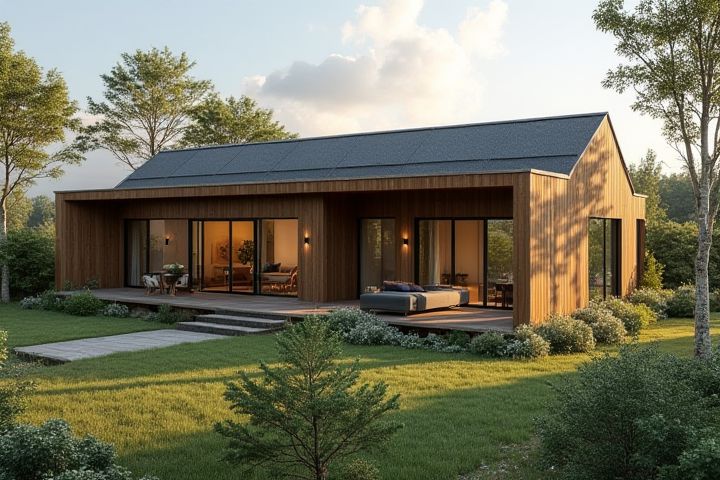
To design a sustainable house, focus on energy efficiency by incorporating solar panels, high-quality insulation, and energy-efficient windows to reduce heating and cooling costs. Use environmentally friendly materials such as reclaimed wood, bamboo, or recycled steel to minimize your home's carbon footprint. Implement water-saving fixtures and a rainwater harvesting system to conserve water and reduce utility bills. Consider passive solar design strategies, including optimal window placement and thermal mass, to maximize natural light and regulate indoor temperatures. Landscape with native plants that require less water and maintenance, promoting biodiversity in your outdoor spaces.
How To Design A Sustainable House
Passive solar design
Incorporating passive solar design in your sustainable house increases energy efficiency by using natural sunlight for heating and cooling, significantly reducing reliance on artificial heating systems. Use large south-facing windows, which can capture heat during the winter months, while strategically placed overhangs can block direct sunlight in the summer, maintaining comfortable indoor temperatures year-round. Utilize high thermal mass materials, such as concrete or stone, to absorb, store, and release heat, stabilizing temperature fluctuations. To further enhance sustainability, consider energy-efficient appliances and solar panels, which can reduce your overall carbon footprint and utility bills.
Energy-efficient appliances
Incorporating energy-efficient appliances is pivotal in designing a sustainable house, as these devices typically use 10-50% less energy than their non-efficient counterparts. When selecting appliances, prioritize Energy Star-rated products, which demonstrate compliance with stringent energy efficiency criteria set by the U.S. Environmental Protection Agency. Additionally, consider integrating smart technology to monitor and optimize energy usage throughout your home, which can lead to significant cost savings over time, potentially reducing your energy bill by up to 30%. Opting for ENERGY STAR appliances can not only lower your carbon footprint but also enhance your home's functionality and comfort.
High-quality insulation
High-quality insulation is essential for a sustainable house, as it minimizes energy consumption by reducing heat loss in winter and heat gain in summer. Use materials like cellulose, sheep's wool, or spray foam for superior thermal performance and environmental benefits, ensuring they have low embodied energy. Proper installation is crucial; ensure there are no gaps or compression in the insulation to maintain its effectiveness, which can involve careful attention to areas like walls, attics, and basements. Implementing air-tight construction techniques alongside high-quality insulation creates a well-balanced thermal envelope, ultimately enhancing your home's energy efficiency and comfort.
Water-saving fixtures
Incorporating water-saving fixtures is essential for creating a sustainable house, as these installations significantly reduce water consumption and promote environmental conservation. Consider using low-flow showerheads, faucets, and dual-flush toilets, which can cut water usage by 20-60% compared to standard models. Elements such as rainwater harvesting systems and greywater recycling can further enhance your home's sustainability, allowing you to reuse water for irrigation and non-potable purposes. Prioritizing high-efficiency appliances like Energy Star-rated dishwashers and washing machines not only contributes to lower water usage but also decreases energy expenditure, creating a more eco-friendly living space.
Sustainable building materials
Sustainable building materials such as bamboo, recycled steel, and reclaimed wood can significantly reduce your carbon footprint while enhancing energy efficiency in your home. Incorporating insulation made from cellulose or sheep's wool not only improves thermal performance but also minimizes environmental impact. Applying non-toxic finishes and low-VOC (volatile organic compounds) paints ensures indoor air quality remains healthy for you and your family. Utilizing solar panels and green roofing can further enhance sustainability, creating a harmonious balance between aesthetics and environmental responsibility.
Green roofing solutions
Incorporating green roofing solutions into your sustainable house design enhances energy efficiency, improves air quality, and provides natural insulation. Consider installing a layered system that includes a waterproof membrane, a root barrier, and a growing medium to support vegetation. Opt for native plant species that require minimal maintenance and irrigation, promoting biodiversity while reducing your environmental footprint. By integrating solar panels atop your green roof, you can further harness renewable energy, making your home not just sustainable but also self-sufficient.
Energy-efficient windows
Incorporating energy-efficient windows can significantly reduce your home's energy consumption, with estimates showing a potential energy savings of 15-30%. Look for windows with low U-factors, ideally below 0.30, which indicates better insulation against heat loss. Double or triple glazing with inert gas fills, such as argon or krypton, enhances thermal performance by minimizing heat transfer. Consider window orientation, as strategically placing them can maximize natural light and reduce reliance on artificial lighting, further contributing to your home's sustainability goals.
Rainwater harvesting systems
Incorporating rainwater harvesting systems into your sustainable house design significantly enhances water efficiency. This involves installing a network of gutters, downspouts, and storage tanks to collect and store rainwater for various uses, such as irrigation and toilet flushing. Utilizing filters and first flush diverters ensures the collected water remains clean and safe for your household needs. By integrating permeable paving and green roofs, you can improve rainwater absorption, reduce runoff, and contribute positively to local ecosystems.
Renewable energy sources
Designing a sustainable house involves integrating renewable energy sources such as solar panels, wind turbines, and geothermal heating. Solar energy systems can significantly reduce your electricity bills by harnessing sunlight to power your home. Wind turbines, in suitable locations, can provide an additional energy source, while geothermal systems utilize the Earth's stable temperature for efficient heating and cooling. Incorporating energy-efficient appliances and insulated materials further enhances sustainability, ensuring your home has a minimal environmental impact while maximizing energy efficiency.
Efficient waste management solutions
Incorporating efficient waste management solutions into your sustainable house design is crucial for minimizing environmental impact. Consider implementing a composting system to recycle organic waste, which can reduce overall waste by up to 30%. Installing a comprehensive recycling station for plastics, paper, and metals will further ensure that at least 50% of your household waste is diverted from landfills. Utilizing materials with a lower environmental footprint, such as reclaimed wood or recycled steel, not only enhances your home's aesthetics but also promotes a closed-loop system that significantly reduces waste.
